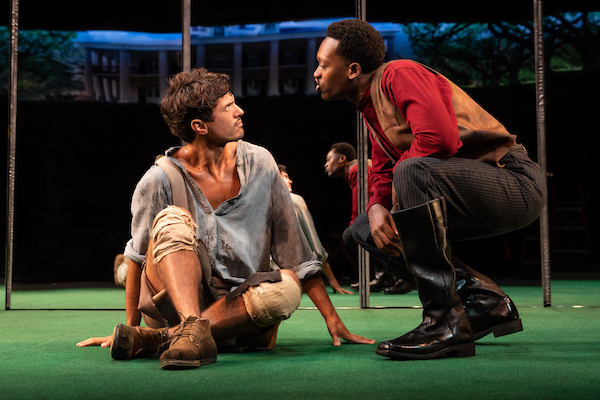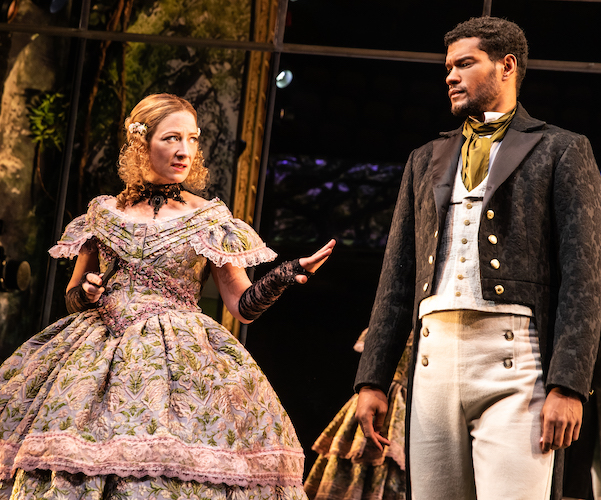Theater Review: A Shattering “Slave Play” Rattles Broadway
By Christopher Caggiano
Jeremy O. Harris’s bold new play is wildly provocative and hysterically funny.
Slave Play by Jeremy O. Harris. Directed by Robert O’Hara. At John Golden Theatre, 252 W. 45th St., New York, New York.

James Cusati-Moyer and Ato Blankson-Wood in “Slave Play.” Photo: Matthew Murphy.
Plays lamenting the national trauma of racial inequity have been a part of American drama at least since the days of Eugene O’Neill and The Emperor Jones (1920). The urge to expose the effects of racism has created a major theatrical subgenre, from Lorraine Hansberry’s A Raisin in the Sun (1959), to Athol Fugard’s “Master Harold”… and the Boys (1982), to the current Broadway smash, To Kill a Mockingbird, adapted by Aaron Sorkin from the Harper Lee classic.
But a recent wave of plays, by an emergent group of smart, strident African-American playwrights, aims to take the examination of racial prejudice to an even deeper level. The focus: progressive complacency and self-satisfaction. It’s one thing to decry the bald-faced hatred of an unrepentant bigot, but it’s quite another to force the audience to examine its own unintentional yet ingrained biases born of institutionalized racism.
One stunning example of this recent trend is the 2018 Pulitzer Prize winner Fairview, by Jackie Sibblies Drury. Fairview is a deeply unsettling but thrillingly meta-theatrical play that dares white audience members to switch places with the black characters on stage—literally switch places, it turns out, as nervous audience members gradually make their way to the stage to challenge their own pat assumptions about what it means to live while black.
Now comes Slave Play, a script that’s not quite as structurally transgressive as Fairview — the show’s fourth wall remains firmly in place — but turns out to be every bit as disquieting. Jeremy O. Harris (at a mere 30 years old) has crafted a play that is both wildly provocative and hysterically funny.
[Warning: There are some fairly significant plot spoilers ahead. But it would be difficult to talk about Slave Play’s impact without them.]
Slave Play delights in creating discomfort, both for its characters and its audience members. The play begins with a series of vignettes that proffer lustful tales of interracial couples in America’s antebellum South. The staging here is shockingly frank — yet strangely riveting. As the play progresses, however, we come to realize that what we are really witnessing is a newfangled form of therapy for mixed-race couples who are experiencing sexual dysfunction.
The therapy group is made up of two straight couples, one gay couple, and the two female therapists, who are also a couple. All four pairs are interracial and, as the therapy sessions kick into high gear, the white participants (predictably) do most of the talking. That is, until their partners have had enough and launch into a series of wildly funny yet shattering diatribes in which Harris makes his most piercing observations about racial and sexual relations in our country today.
Director Robert O’Hara proves himself deft at presenting both the rambunctious physical comedy of the play’s first section and the subtle, seething psychological tensions of the second. O’Hara is determined to keep the audience off balance; Clint Ramos’s scenic design aids and abets this calculation to keep things akimbo. A wall of smoky mirrors onstage reflects the entire audience as well as a long horizontal photograph of a plantation, which is placed across the lip of the balcony. This creates an eerie, fluid, dreamy reflection of the Antebellum South, suggesting a memory that has become slightly faded but remains vivid.
The group therapy section of the play features a rip-roaring send-up of market branded psychobabble. The performances from Chalia La Tour and Irene Sofia Lucio as the group therapists often feel broader than is necessary; they almost throw off O’Hara’s otherwise well-balanced ship. Still, as the cracks in their own romantic relationship are revealed, their interactions create a neat parallel for the relationships of the therapy participants.

Annie McNamara and Sullivan Jones in “Slave Play.” Photo: Matthew Murphy.
Annie McNamara gets a good share of the show’s plentiful laughs, first as a lusty plantation mistress and then during the therapy sequence as Harris’s stand-in for all those liberals who try so hard to be “woke.” She takes profuse notes and reads all the right books, but despite (or because of) her dedication she is ignorant of her own unbalanced inventory. Sullivan Jones is an understated marvel as her strapping black husband, who slowly comes to see that his supposed racism-free existence is rife with slights and resentments.
Joaquina Kalukango is the only cast member who wasn’t part of the New York Theatre Workshop Off-Broadway run. She is alternately smoldering and explosive as Kaneisha, the repressed African-American wife of a tightly wound white husband, Jim (Paul Alexander Nolan, who after the indignities of Doctor Zhivago, Bright Star, and Escape to Margaritaville, has finally found a production worthy of his considerable talents). Kalukango’s tour de force final monologue — and her character’s climactic interaction with her husband — bring the play and Harris’s racial treatise to a shattering climax.
As powerful as Harris’s script is, it’s not entirely clear what he wants us to take away from the turmoil of his interracial couples. Is he saying such pairings will inescapably be undermined — perhaps destroyed? — by entrenched institutional racism? If so, that simplifies through hyperbole. The therapeutic methods presented in Slave Play fail quite miserably, but it’s not clear if the dramatist is arguing that these methods are flawed — or that these couples were pretty well doomed from the beginning. In the final lines of the play, however, Harris seems to suggest the possibility of redemption. But is this too little too late?
Christopher Caggiano is a writer and teacher based in Boston. He serves as Associate Professor of Theater at the Boston Conservatory at Berklee. His writing has appeared in American Theatre and Dramatics magazines, and on TheaterMania.com and ZEALnyc.com.

For Boston’s resolutely cautious theaters, Broadway always knows best. So now that Slave Play is on the Great White Way, might our companies consider doing edgier fare on race? Is it ok now? Is the coast clear? Any takers on Fairview?
I would be all for that. All about finding the right venue. It would work in the Calderwood, I think. Or at the Central Square.
Saw it in ny. Would definitely work in Boston at central square or calderwood.